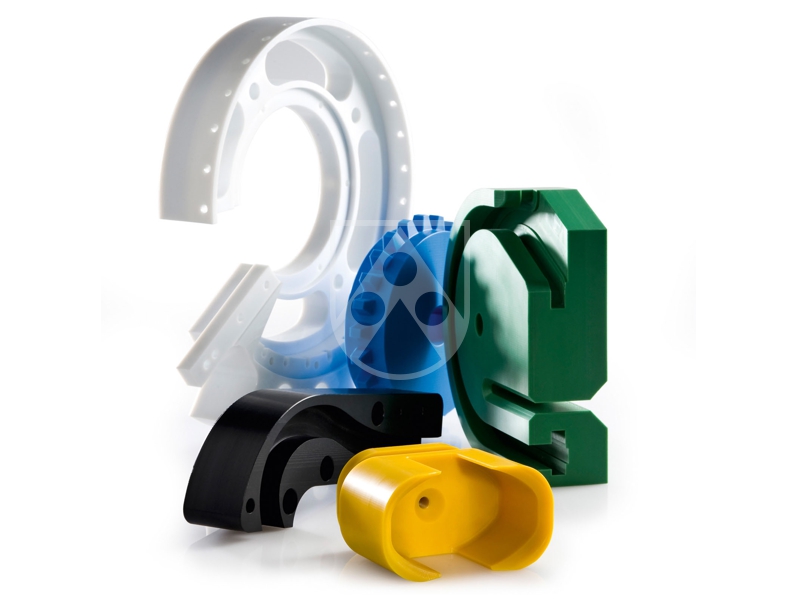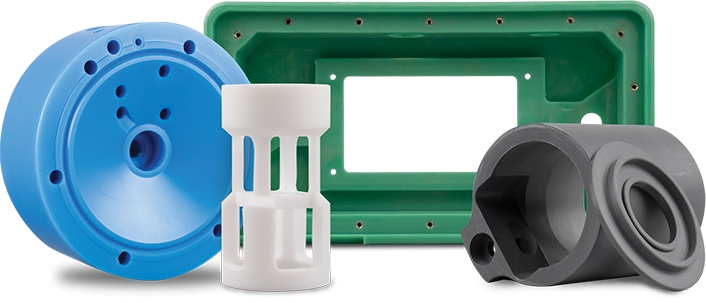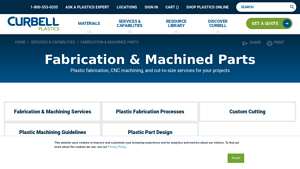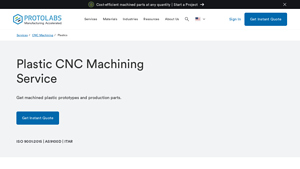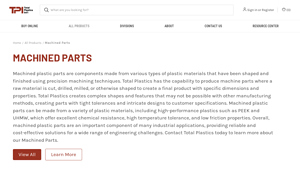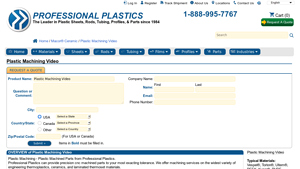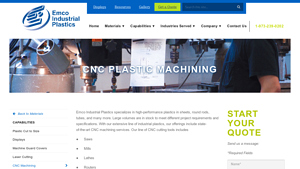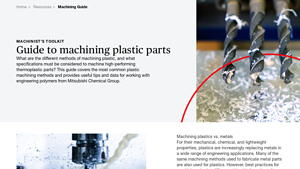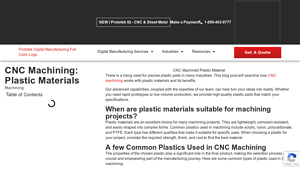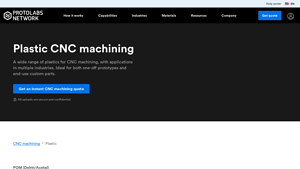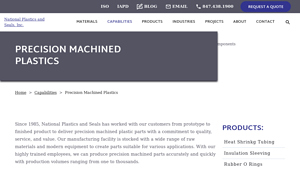Machined Plastic Parts Guide: Type, Cost, Top List…
Introduction: Navigating the Global Market for machined plastic parts
In today’s competitive landscape, sourcing high-quality machined plastic parts presents a significant challenge for international B2B buyers. From Africa to South America, the Middle East, and Europe, businesses must navigate a myriad of options while ensuring that they meet specific industry standards and requirements. This guide aims to demystify the global market for machined plastic parts, providing actionable insights into various types, applications, and the intricacies of supplier vetting.
With a focus on materials ranging from ABS to PEEK, and applications across sectors such as aerospace, medical devices, and packaging, we cover the essential considerations for making informed purchasing decisions. Buyers will find detailed information on cost factors, manufacturing processes, and the importance of quality certifications like ISO standards. By understanding these elements, companies can better align their procurement strategies with operational needs and market demands.
Moreover, this guide empowers B2B buyers to identify reliable suppliers who can meet their unique specifications. Whether you are located in Germany or Brazil, navigating the complexities of sourcing machined plastic parts will be streamlined through our comprehensive analysis and practical recommendations. As you delve into this resource, you will gain the confidence to make choices that enhance your operational efficiency and product quality.
Understanding machined plastic parts Types and Variations
| Type Name | Key Distinguishing Features | Primary B2B Applications | Brief Pros & Cons for Buyers |
|---|---|---|---|
| CNC Machined Parts | High precision, customizable geometries, varied materials | Aerospace, automotive, medical devices | Pros: High accuracy, tailored designs. Cons: Higher initial costs. |
| Injection Molded Parts | Mass production capabilities, complex shapes | Consumer products, industrial equipment | Pros: Cost-effective for large volumes. Cons: Less flexibility for design changes. |
| Thermoformed Parts | Lightweight, adaptable to various shapes | Packaging, medical trays, automotive interiors | Pros: Quick production turnaround. Cons: Limited to simpler shapes. |
| 3D Printed Parts | Rapid prototyping, intricate designs | Prototyping, custom tooling, small batch production | Pros: Fast lead times, design flexibility. Cons: Material limitations and potential durability issues. |
| Machined Sheet Parts | Flat sheets cut and machined to specifications | Signage, HVAC components, custom fixtures | Pros: Versatile applications, easy to source. Cons: May require additional finishing processes. |
What are CNC Machined Parts and Their Applications?
CNC machined parts are crafted using computer numerical control technology, allowing for high precision and the ability to create complex geometries. These parts are suitable for industries such as aerospace and medical devices, where accuracy is paramount. When purchasing CNC machined components, buyers should consider the tolerances required, the type of plastic material that best fits their application, and the machining capabilities of the supplier to ensure they meet their specific needs.
How Do Injection Molded Parts Differ from Other Types?
Injection molded parts are produced by injecting molten plastic into a mold, making them ideal for mass production. They are commonly used in consumer products and industrial equipment due to their ability to create complex shapes efficiently. Buyers should weigh the advantages of lower per-unit costs against the need for initial mold creation, which can be expensive. This type is best for projects with high volume requirements and stable designs.
What Advantages Do Thermoformed Parts Offer?
Thermoformed parts are created by heating plastic sheets until pliable and then shaping them into desired forms. They are lightweight and can be adapted to various shapes, making them popular in packaging and medical applications. Buyers must consider the design complexity and the potential for lower production costs, especially for short runs. However, thermoforming may not be suitable for highly intricate designs, limiting its application in more demanding environments.
Why Choose 3D Printed Parts for Prototyping?
3D printed parts are produced using additive manufacturing, which allows for rapid prototyping and the creation of intricate designs that traditional machining methods may not achieve. This method is particularly useful for small batch production and custom tooling. Buyers should evaluate the material options available, as well as the durability of the final product, to ensure it meets their functional requirements. The speed of production is a significant advantage, especially in fast-paced industries.
What are the Benefits of Machined Sheet Parts?
Machined sheet parts involve cutting and machining flat plastic sheets to specific dimensions and shapes. They are versatile and widely used in applications such as signage and HVAC components. Buyers should consider the ease of sourcing materials and the potential need for additional finishing processes to achieve the desired quality. While these parts are adaptable, they may not offer the same level of complexity as molded or machined components, making them best for straightforward applications.
Key Industrial Applications of machined plastic parts
| Industry/Sector | Specific Application of machined plastic parts | Value/Benefit for the Business | Key Sourcing Considerations for this Application |
|---|---|---|---|
| Aerospace | Custom components for aircraft interiors | Lightweight materials reduce fuel consumption and enhance design flexibility | Compliance with aviation standards; material certifications |
| Medical Devices | Prosthetics and orthotic devices | Improved patient comfort and functional performance | Biocompatibility; precision tolerances; FDA compliance |
| Food Processing | Hygienic cutting boards and conveyor parts | Enhances safety and efficiency in food handling | FDA-approved materials; easy cleanability; durability |
| Semiconductor | Component housings and insulators | High dielectric strength and thermal stability | Material selection for chemical resistance; precision machining capabilities |
| Packaging | Custom packaging solutions | Cost-effective and lightweight alternatives to traditional materials | Customization options; sustainability considerations; lead times |
How Are Machined Plastic Parts Utilized in Aerospace Applications?
In the aerospace sector, machined plastic parts are critical for creating custom components such as interior fittings and lightweight structural elements. These parts are designed to minimize weight, which directly translates to fuel savings and enhanced performance. Buyers in this industry must ensure that the materials used comply with stringent aviation standards and possess the necessary certifications to guarantee safety and reliability.
What Role Do Machined Plastic Parts Play in Medical Devices?
Machined plastic parts are extensively used in the production of prosthetics and orthotic devices, where comfort and functional performance are paramount. These components are tailored to meet specific patient needs, significantly improving usability and overall satisfaction. International buyers should prioritize suppliers who can provide biocompatible materials and demonstrate expertise in precision machining, adhering to FDA compliance for medical applications.
Why Are Machined Plastic Parts Important in Food Processing?
In the food processing industry, machined plastic parts, such as hygienic cutting boards and conveyor components, are essential for maintaining safety and efficiency. These parts are designed for easy cleaning and sanitation, helping to prevent contamination. When sourcing these components, businesses must consider FDA-approved materials that offer durability and can withstand rigorous cleaning processes.
How Do Machined Plastic Parts Benefit the Semiconductor Industry?
The semiconductor industry utilizes machined plastic parts for creating component housings and insulators that require high dielectric strength and thermal stability. These properties are crucial for protecting sensitive electronic components from environmental factors. Buyers should focus on suppliers who offer materials with excellent chemical resistance and precision machining capabilities to meet the complex specifications of this sector.
What Are the Advantages of Machined Plastic Parts in Packaging Solutions?
Custom packaging solutions made from machined plastic parts provide cost-effective and lightweight alternatives to traditional materials. These solutions can be tailored to specific products, enhancing protection and presentation. When sourcing, businesses should consider customization options, sustainability practices, and lead times to ensure that their packaging meets market demands while also aligning with eco-friendly initiatives.
3 Common User Pain Points for ‘machined plastic parts’ & Their Solutions
Scenario 1: Sourcing Quality Materials for Machined Plastic Parts
The Problem: Many B2B buyers face the challenge of sourcing high-quality materials for machined plastic parts. This is particularly crucial in industries such as aerospace, automotive, and medical devices, where material performance directly impacts safety and functionality. Buyers often encounter issues such as inconsistent quality, lack of traceability, and limited options for specialized plastics that meet stringent regulatory standards. For instance, a manufacturer may receive a batch of plastic that fails to meet the necessary tensile strength or chemical resistance specifications, leading to costly delays and potential safety risks.
The Solution: To overcome these challenges, it is essential to establish strong relationships with reputable suppliers who prioritize quality and compliance. Start by conducting thorough research on potential suppliers, focusing on their certifications (such as ISO 9001 and AS9100) and their history of servicing your specific industry. Utilize material selection tools that help you identify the best plastics based on properties like tensile strength and chemical resistance. Additionally, request samples and documentation that verify the material’s performance under expected conditions. By ensuring that your suppliers have a robust quality assurance process, you can mitigate risks associated with material inconsistency and ensure the reliability of your machined parts.
Scenario 2: Navigating Complex Design Specifications for Machined Parts
The Problem: Another common pain point for B2B buyers is the complexity involved in designing machined plastic parts that meet specific application requirements. Industries such as medical devices or automotive often demand intricate geometries and tight tolerances. Buyers may struggle with translating their design concepts into manufacturable parts due to limited knowledge of machining capabilities and material behavior. This can result in prototypes that do not fit or function as intended, leading to wasted resources and time.
The Solution: To address this issue, engage with suppliers early in the design process. Collaboration with your manufacturing partner can provide valuable insights into material selection and machining capabilities, helping you refine your designs for manufacturability. Utilize design guidelines that outline the maximum part sizes, minimum dimensions, and best practices for machining specific plastics. Consider leveraging advanced technologies such as CAD software to simulate the machining process and identify potential design flaws before production. By fostering a collaborative approach and leveraging technological tools, you can create designs that not only meet specifications but are also optimized for efficient machining.
Scenario 3: Managing Lead Times and Production Scalability
The Problem: B2B buyers often face significant challenges related to lead times and the scalability of production for machined plastic parts. In fast-paced industries, delays in receiving parts can disrupt the entire supply chain and impact project timelines. Buyers may find themselves at the mercy of suppliers who cannot scale production quickly enough to meet fluctuating demand or who have long lead times due to inefficient processes or limited machinery.
The Solution: To effectively manage lead times, consider implementing an inventory management program with your supplier that ensures a steady supply of critical materials and pre-manufactured parts. Establish clear communication channels to keep abreast of production schedules and potential delays. Additionally, assess your supplier’s production capabilities to ensure they have the necessary machinery, such as CNC milling and turning machines, to handle large volumes and complex orders. Opt for suppliers who offer rapid prototyping services, as they can significantly reduce time-to-market for new products. By proactively managing your supply chain and choosing partners who can adapt to your needs, you can minimize delays and ensure a more reliable production process.
Strategic Material Selection Guide for machined plastic parts
What Are the Key Properties of Common Materials for Machined Plastic Parts?
When selecting materials for machined plastic parts, it’s essential to consider their properties, performance, and suitability for specific applications. Here, we analyze four common materials: Polycarbonate, Nylon, PEEK, and PVC.
Polycarbonate: Versatile and Impact-Resistant
Key Properties: Polycarbonate is known for its high impact resistance and transparency. It can withstand temperatures ranging from 270°F to 280°F and offers excellent dimensional stability.
Pros & Cons: The primary advantage of polycarbonate is its durability and ability to resist shattering, making it ideal for safety applications. However, it can be more expensive than other plastics and may require specialized machining techniques due to its toughness.
Impact on Application: Polycarbonate is suitable for applications requiring high strength and clarity, such as protective covers and lenses. Its impact resistance makes it ideal for environments where safety is a concern.
Considerations for International Buyers: Compliance with international standards, such as ASTM and DIN, is crucial. Buyers from regions like Europe may prefer materials that meet stringent safety and environmental regulations.
Nylon: Strong and Wear-Resistant
Key Properties: Nylon, particularly Nylon 6 and Nylon 6/6, exhibits excellent tensile strength (up to 10,000 psi) and good wear resistance. It operates effectively at temperatures ranging from 200°F to 455°F.
Pros & Cons: Nylon’s strength and low friction properties make it suitable for bearings and gears. However, it can absorb moisture, which may affect dimensional stability and mechanical properties over time.
Impact on Application: Nylon is commonly used in applications requiring durability and wear resistance, such as automotive components and industrial machinery. Its ability to withstand high loads makes it a popular choice.
Considerations for International Buyers: Buyers should be aware of moisture absorption issues and consider sourcing nylon that meets specific moisture resistance standards. Compliance with ISO standards is often expected in European markets.
PEEK: High-Performance Thermoplastic
Key Properties: PEEK is a high-performance thermoplastic known for its excellent mechanical properties, including a tensile strength of 14,000 psi and a heat resistance of up to 482°F. It also offers outstanding chemical resistance.
Pros & Cons: PEEK is ideal for demanding applications in aerospace and medical industries due to its thermal stability and chemical resistance. However, it is one of the more expensive options, which could impact project budgets.
Impact on Application: PEEK is suitable for applications in harsh environments, such as chemical processing and high-temperature settings. Its durability makes it a preferred choice for components that require long service life.
Considerations for International Buyers: Buyers must consider the high cost of PEEK and ensure that it meets relevant industry standards, such as ASTM and FDA compliance, particularly in medical applications.
PVC: Cost-Effective and Chemically Resistant
Key Properties: PVC is a widely used thermoplastic known for its chemical resistance and low cost. It can withstand temperatures up to 172°F and is relatively easy to machine.
Pros & Cons: The primary advantage of PVC is its affordability and versatility, making it suitable for various applications. However, it may not perform well under high temperatures and can become brittle over time.
Impact on Application: PVC is often used in plumbing, electrical insulation, and packaging applications due to its chemical resistance. Its low cost makes it an attractive option for budget-conscious projects.
Considerations for International Buyers: Buyers should ensure that PVC products meet local regulations regarding environmental impact and chemical safety. Compliance with standards such as ASTM is critical in many regions, including Europe and North America.
Summary Table of Material Properties and Suitability
| Material | Typical Use Case for machined plastic parts | Key Advantage | Key Disadvantage/Limitation | Relative Cost (Low/Med/High) |
|---|---|---|---|---|
| Polycarbonate | Safety shields, lenses | High impact resistance and clarity | Higher cost and specialized machining | High |
| Nylon | Bearings, gears | Excellent strength and wear resistance | Moisture absorption affects stability | Medium |
| PEEK | Aerospace, medical components | Outstanding thermal and chemical resistance | High cost | High |
| PVC | Plumbing, electrical insulation | Cost-effective and versatile | Limited high-temperature performance | Low |
This strategic material selection guide provides crucial insights for international B2B buyers, helping them make informed decisions based on material properties, application suitability, and compliance considerations.
In-depth Look: Manufacturing Processes and Quality Assurance for machined plastic parts
What Are the Key Stages in the Manufacturing Processes for Machined Plastic Parts?
The manufacturing of machined plastic parts involves several critical stages, each designed to ensure precision, efficiency, and quality. Understanding these stages is essential for B2B buyers looking to partner with reliable suppliers.
Material Preparation: How Are Raw Materials Selected and Processed?
The first step in the manufacturing process is the selection and preparation of raw materials. Suppliers often maintain a diverse inventory of thermoplastics, such as ABS, nylon, and PEEK, which are chosen based on their mechanical properties and suitability for specific applications.
Once selected, the materials undergo cutting, shaping, or other preparatory processes to achieve the desired dimensions and characteristics. Techniques such as CNC (Computer Numerical Control) machining and laser cutting are commonly employed to ensure accuracy and repeatability.
Forming: What Techniques Are Used to Shape Machined Plastic Parts?
After preparation, the forming stage begins. This involves the actual machining of the plastic materials into the specified shapes and sizes. Key techniques include:
-
CNC Machining: This is the most prevalent method, allowing for the creation of intricate designs and tight tolerances. CNC machines can perform various operations, including milling, turning, and drilling.
-
Injection Molding: While not exclusive to machining, this process is essential for producing high volumes of parts with consistent quality. It involves injecting molten plastic into a mold, where it cools and hardens.
-
3D Printing: Increasingly popular for prototyping, 3D printing allows for the rapid production of complex geometries, although it may not always be suitable for high-volume production.
Each of these techniques has its advantages and is selected based on the specific requirements of the project, including volume, complexity, and material properties.
Assembly: How Are Machined Plastic Parts Assembled?
In many cases, machined plastic parts require assembly with other components. This can involve methods such as gluing, welding, or mechanical fastening. The assembly process is critical, particularly for parts that will be integrated into larger systems or products.
B2B buyers should inquire about the assembly capabilities of their suppliers, especially for projects that require multi-component assemblies or specialized joining techniques.
Finishing: What Are the Post-Manufacturing Treatment Processes?
The finishing stage enhances the surface quality and functional characteristics of the machined parts. Techniques may include:
-
Edge Finishing: This involves smoothing out edges to prevent sharp corners and enhance safety.
-
Coating and Painting: To improve aesthetics or add protective layers, coatings may be applied to the machined parts.
-
Quality Checks: Before final delivery, parts undergo rigorous quality control checks to ensure they meet specified tolerances and surface finishes.
How Is Quality Assurance Implemented in Machined Plastic Parts Manufacturing?
Quality assurance (QA) is paramount in the manufacturing process, ensuring that the final products meet both international and industry-specific standards.
What International Standards Should B2B Buyers Be Aware Of?
ISO 9001:2015 is a widely recognized standard that outlines the criteria for a quality management system. Companies adhering to this standard demonstrate their commitment to quality through consistent processes and customer satisfaction.
In addition to ISO certifications, industry-specific standards such as CE marking for products sold in Europe or API standards for oil and gas components may also apply. Buyers should verify that their suppliers possess relevant certifications that align with their industry requirements.
What Are the Key Quality Control Checkpoints in the Manufacturing Process?
Quality control is integrated at various stages of the manufacturing process, typically categorized into three key checkpoints:
-
Incoming Quality Control (IQC): This involves inspecting raw materials upon arrival to ensure they meet specified quality standards. Buyers should request documentation of these inspections.
-
In-Process Quality Control (IPQC): During the manufacturing process, continuous monitoring is conducted to identify any deviations from quality standards. This includes regular checks of dimensions, tolerances, and surface finishes.
-
Final Quality Control (FQC): Before shipping, the final products undergo thorough inspections to ensure they meet the required specifications. Buyers can request FQC reports that detail the results of these inspections.
How Can B2B Buyers Verify Supplier Quality Control Practices?
For B2B buyers, verifying a supplier’s quality control practices is essential for ensuring product reliability. Here are several approaches:
-
Supplier Audits: Conducting regular audits of suppliers allows buyers to assess their quality control processes firsthand. This can include reviewing documentation, observing operations, and evaluating compliance with standards.
-
Quality Reports: Requesting quality assurance reports can provide insights into the supplier’s performance history, including defect rates and corrective actions taken.
-
Third-Party Inspections: Engaging third-party inspection services can offer an unbiased assessment of a supplier’s quality control measures and product quality.
What Are the Nuances of Quality Control for International B2B Buyers?
International buyers, particularly from diverse regions such as Africa, South America, the Middle East, and Europe, must navigate various challenges in quality assurance.
-
Cultural Differences: Understanding the cultural context of suppliers can aid in establishing effective communication and expectations regarding quality.
-
Regulatory Compliance: Different regions may have specific regulations governing product quality and safety. Buyers should be familiar with these regulations and ensure their suppliers comply.
-
Logistical Considerations: Quality control practices may be impacted by logistical challenges, such as shipping delays or customs inspections. Buyers should factor these into their quality assurance strategies to mitigate risks.
By comprehensively understanding the manufacturing processes and quality assurance practices associated with machined plastic parts, B2B buyers can make informed decisions and establish successful partnerships with suppliers.
Practical Sourcing Guide: A Step-by-Step Checklist for ‘machined plastic parts’
Introduction
Sourcing machined plastic parts can be a complex process, especially for international buyers navigating diverse markets. This guide provides a step-by-step checklist to streamline your procurement efforts, ensuring you find high-quality components that meet your specific needs while minimizing risks. Follow these actionable steps to enhance your sourcing strategy and ensure successful partnerships with suppliers.
Step 1: Define Your Technical Specifications
Clearly outlining your technical requirements is crucial for effective sourcing. Consider dimensions, tolerances, material properties, and performance criteria specific to your application. This clarity will not only facilitate better communication with suppliers but also ensure that the parts you receive meet your operational needs.
- Key Specifications to Include:
- Material Type: Identify the specific type of plastic, such as ABS, PEEK, or Nylon, based on your application requirements.
- Performance Characteristics: Specify tensile strength, heat resistance, and chemical compatibility.
Step 2: Research Potential Suppliers
Conduct thorough research to identify reliable suppliers capable of meeting your needs. Look for companies with a proven track record in manufacturing machined plastic parts, particularly those with experience in your industry.
- Considerations:
- Certifications: Check for industry certifications such as ISO 9001 to ensure quality management practices.
- Experience: Review the supplier’s history and expertise in producing similar parts.
Step 3: Evaluate Supplier Capabilities
Assess the technical capabilities of potential suppliers to ensure they can deliver the required parts within specified tolerances and quality standards. This includes evaluating their machinery, technology, and production capacity.
- Key Areas to Investigate:
- Machining Technology: Confirm that they utilize modern CNC machining centers and have the capability for complex geometries.
- Production Volume: Ensure they can handle both prototype and large-scale production needs.
Step 4: Request Samples and Prototypes
Before making a large commitment, request samples or prototypes of your parts. This step is essential for verifying the quality and precision of the machined components.
- What to Look For:
- Quality Assurance: Evaluate the samples for adherence to your specifications, including dimensions and surface finish.
- Testing: Consider conducting performance tests to ensure the parts meet operational requirements.
Step 5: Verify Supply Chain and Logistics
Understanding the supplier’s logistics capabilities is vital for timely delivery and cost management. Assess their supply chain efficiency to avoid potential delays in production or shipping.
- Logistics Considerations:
- Lead Times: Inquire about standard lead times for production and shipping.
- Shipping Options: Ensure they can accommodate your preferred shipping methods and timelines.
Step 6: Negotiate Terms and Conditions
Once you have identified a suitable supplier, negotiate favorable terms and conditions. This includes pricing, payment terms, delivery schedules, and warranty policies.
- Important Aspects to Negotiate:
- Pricing Models: Discuss volume discounts or long-term partnership agreements.
- Quality Guarantees: Establish clear terms for quality assurance and recourse for defective parts.
Step 7: Monitor Supplier Performance
After placing your order, continue to monitor the supplier’s performance throughout the production process. Maintain open lines of communication to address any issues promptly.
- Performance Metrics to Track:
- On-Time Delivery: Keep track of whether shipments meet agreed timelines.
- Quality Control: Regularly review the quality of received parts against your specifications.
By following this checklist, you can effectively navigate the complexities of sourcing machined plastic parts, ensuring that you partner with reliable suppliers who can meet your technical and operational requirements.
Comprehensive Cost and Pricing Analysis for machined plastic parts Sourcing
What Are the Key Cost Components in Sourcing Machined Plastic Parts?
When sourcing machined plastic parts, understanding the cost structure is crucial for effective budgeting and procurement. The primary cost components include:
-
Materials: The choice of material significantly impacts cost. Engineering-grade plastics like ABS and Nylon tend to be more affordable, while high-performance materials like PEEK and PEI come with a premium due to their superior properties. The market price of these materials can fluctuate based on global supply and demand, which can be particularly relevant for international buyers.
-
Labor: Labor costs are influenced by the complexity of machining operations and the skill level required. Regions with lower labor costs may offer competitive pricing; however, the quality of workmanship is paramount. It’s advisable to assess the labor environment in the supplier’s location.
-
Manufacturing Overhead: This includes costs related to facility maintenance, utilities, and administrative expenses. Suppliers with advanced machinery may incur higher overhead, which could be reflected in the pricing.
-
Tooling: Custom tooling can be a significant upfront investment, particularly for unique parts. The cost of tooling is often amortized over the production run, making larger orders more cost-effective in the long term.
-
Quality Control (QC): Rigorous quality control processes ensure that parts meet specifications and standards. This can add to the overall cost but is essential for reducing defects and ensuring compliance with industry regulations.
-
Logistics: Transportation costs can vary widely, especially for international shipments. Factors such as distance, shipping method, and Incoterms can influence logistics expenses. It’s crucial to consider these costs in relation to the overall pricing strategy.
-
Margin: Suppliers will typically add a markup to cover their costs and profit margin. Understanding the typical margins in the industry can help buyers assess whether quotes are competitive.
How Do Volume and Customization Affect Pricing for Machined Plastic Parts?
Pricing is heavily influenced by order volume and the level of customization required. Generally, larger orders reduce the per-unit cost due to economies of scale. Many suppliers set Minimum Order Quantities (MOQs), which can affect pricing strategies for international buyers.
Customization, while often necessary for specific applications, can add to costs. Complex designs or unique specifications may require specialized tooling or longer machining times, impacting the final price. Buyers should clearly communicate their requirements upfront to receive accurate quotes.
What Supplier Factors Should Buyers Consider When Sourcing?
Selecting the right supplier involves evaluating several factors:
-
Experience and Expertise: Suppliers with a strong track record in specific industries may command higher prices but can provide better quality and reliability.
-
Certifications: Compliance with international quality standards (e.g., ISO certifications) can influence pricing. Suppliers with certifications may charge more, but this often correlates with superior product quality and reliability.
-
Geographical Location: Sourcing from suppliers in regions with favorable trade agreements or lower logistics costs can lead to more competitive pricing.
What Are the Best Negotiation Strategies for International Buyers?
When negotiating with suppliers, especially in diverse regions such as Africa, South America, the Middle East, and Europe, consider the following tips:
-
Understand Total Cost of Ownership (TCO): Beyond the initial price, evaluate the long-term costs associated with quality, durability, and maintenance. A lower upfront cost may lead to higher TCO if the parts fail prematurely.
-
Leverage Competitive Quotes: Gathering multiple quotes can provide leverage in negotiations. Ensure that all quotes reflect similar specifications for an apples-to-apples comparison.
-
Discuss Payment Terms: Flexible payment terms can sometimes be negotiated, allowing for improved cash flow.
-
Be Aware of Pricing Nuances: Currency fluctuations, tariffs, and trade regulations can affect pricing for international buyers. Understanding these nuances can aid in making informed decisions.
Are There Any Price Disclaimers International Buyers Should Be Aware Of?
It is essential for buyers to recognize that prices for machined plastic parts can vary significantly based on the factors discussed. Prices quoted are often indicative and can change based on market conditions, material availability, and other variables. Engaging in continuous dialogue with suppliers will help ensure that pricing remains transparent and up-to-date.
Alternatives Analysis: Comparing machined plastic parts With Other Solutions
Exploring Alternatives to Machined Plastic Parts: A Comparative Analysis
In the realm of industrial manufacturing, choosing the right component fabrication method is crucial for optimizing product performance and cost-effectiveness. While machined plastic parts offer unique advantages, several alternative solutions can also meet specific needs. This section compares machined plastic parts with two viable alternatives: injection-molded plastic parts and 3D-printed components. Understanding the strengths and weaknesses of each option will help B2B buyers make informed decisions.
| Comparison Aspect | Machined Plastic Parts | Injection-Molded Plastic Parts | 3D-Printed Components |
|---|---|---|---|
| Performance | High precision, tight tolerances, suitable for complex geometries. | Excellent for high-volume production with consistent quality. | Versatile design freedom, suitable for rapid prototyping. |
| Cost | Higher per-unit cost, especially for low volumes. | Lower cost per unit at scale; high upfront tooling costs. | Cost-effective for low volumes; material waste can be higher. |
| Ease of Implementation | Requires skilled labor and advanced machinery; longer lead times. | Requires significant setup and tooling; best for large runs. | Quick setup and modification; ideal for small batches. |
| Maintenance | Low maintenance, but machinery requires regular calibration. | Low once set up, but molds can wear over time. | Minimal maintenance, but print quality can vary. |
| Best Use Case | Custom, low to medium volume parts requiring high precision. | High-volume production of standardized parts. | Prototyping and complex geometries that need quick iterations. |
Injection-Molded Plastic Parts: Pros and Cons
Injection molding is a widely used manufacturing process that involves injecting molten plastic into a mold to create parts. This method excels in high-volume production, where the cost per unit decreases significantly as the number of parts increases. The initial investment in molds and tooling can be substantial, making it less suitable for low-volume projects. However, once in production, injection-molded parts maintain high quality and consistency, making them ideal for products requiring uniformity.
Pros:
– Cost-efficient for large production runs.
– High consistency and quality.
Cons:
– High initial setup costs.
– Limited design flexibility compared to machining.
3D-Printed Components: Pros and Cons
3D printing, or additive manufacturing, creates parts layer by layer from a digital model. This technology offers unparalleled design flexibility and is particularly advantageous for prototyping, allowing for rapid iterations without the need for complex tooling. While 3D printing can be cost-effective for low-volume production, it may generate higher material waste and have slower production speeds compared to traditional methods.
Pros:
– Excellent for prototyping and complex designs.
– Quick modifications and shorter lead times.
Cons:
– Can be costlier per unit for larger volumes.
– Quality may vary based on the printer and material used.
Choosing the Right Solution for Your Needs
When evaluating the best fabrication method, B2B buyers should consider several factors, including volume requirements, budget constraints, and specific performance needs. For projects demanding high precision in low to medium volumes, machined plastic parts stand out as the best option. Conversely, injection molding is ideal for high-volume production where cost efficiency is critical. For rapid prototyping or when design flexibility is paramount, 3D printing may be the best fit. By carefully analyzing these alternatives, buyers can select the most appropriate solution tailored to their unique project requirements.
Essential Technical Properties and Trade Terminology for machined plastic parts
What Are the Critical Technical Properties of Machined Plastic Parts?
Understanding the technical properties of machined plastic parts is crucial for B2B buyers, as these specifications directly impact the performance and application of the components in various industries. Here are some essential properties to consider:
1. Material Grade
The material grade refers to the specific type of plastic used in manufacturing, such as ABS, Nylon, or PEEK. Each material has unique properties, including tensile strength, impact resistance, and thermal stability. For B2B buyers, selecting the appropriate material grade ensures that the machined parts will meet the specific demands of their applications, whether in aerospace, medical devices, or consumer goods.
2. Tolerance
Tolerance defines the acceptable limit of variation in a physical dimension of the machined part. Tight tolerances are critical in applications that require precise fitting and functionality, such as in automotive or aerospace components. For buyers, understanding tolerance requirements is essential to ensure that parts will fit properly and function as intended, reducing the risk of assembly issues or product failure.
3. Heat Deflection Temperature (HDT)
HDT indicates the temperature at which a plastic material deforms under a specified load. This property is crucial for applications involving high temperatures, such as in electrical housings or automotive parts. For B2B buyers, knowing the HDT helps in selecting materials that will not warp or lose structural integrity during operation, ensuring longevity and reliability.
4. Chemical Resistance
The ability of a plastic material to resist degradation when exposed to chemicals is vital in industries such as pharmaceuticals and food processing. Buyers must assess the chemical compatibility of the plastic with the substances it will encounter, which helps prevent premature failure or safety hazards.
5. Surface Finish
Surface finish refers to the texture and smoothness of the machined part. A high-quality surface finish can enhance aesthetics and reduce friction in moving parts. For B2B buyers, understanding surface finish requirements can influence both the performance and the overall cost of production, as different finishes may require additional machining processes.
What Common Trade Terms Should B2B Buyers Know?
Familiarity with industry jargon is essential for effective communication and negotiation in the B2B landscape. Here are some common terms related to machined plastic parts:
1. OEM (Original Equipment Manufacturer)
An OEM is a company that produces parts or equipment that may be marketed by another manufacturer. Understanding OEM relationships is crucial for buyers looking to source high-quality components that meet specific standards and certifications.
2. MOQ (Minimum Order Quantity)
MOQ refers to the minimum number of units that a supplier is willing to sell in a single order. Knowing the MOQ helps buyers plan their purchasing strategies and manage inventory effectively, particularly in industries with fluctuating demand.
3. RFQ (Request for Quotation)
An RFQ is a formal process where a buyer requests pricing and terms from suppliers for specific products or services. For B2B buyers, issuing RFQs can streamline the procurement process, ensuring competitive pricing and terms from multiple suppliers.
4. Incoterms (International Commercial Terms)
Incoterms are standardized trade terms that define the responsibilities of buyers and sellers in international transactions. Understanding Incoterms is vital for B2B buyers engaged in global sourcing, as they clarify shipping responsibilities, risk management, and cost allocation.
5. CNC (Computer Numerical Control)
CNC refers to the automated control of machining tools by a computer. This technology is widely used in the production of machined plastic parts, allowing for high precision and efficiency. For buyers, understanding CNC capabilities can influence their choice of suppliers and the feasibility of producing complex designs.
By familiarizing themselves with these technical properties and trade terms, B2B buyers can make more informed decisions, ensuring that their machined plastic parts meet the required specifications and industry standards.
Navigating Market Dynamics and Sourcing Trends in the machined plastic parts Sector
What Are the Key Market Drivers and Trends Affecting Machined Plastic Parts?
The machined plastic parts sector is experiencing transformative growth driven by several global factors. The increasing demand for lightweight and corrosion-resistant materials across industries such as aerospace, automotive, and medical is propelling the use of advanced plastics. Additionally, the rise of automation and Industry 4.0 technologies, including CNC machining and additive manufacturing, is enhancing production capabilities, enabling higher precision and reduced lead times. This shift is particularly relevant for international B2B buyers in regions like Africa, South America, the Middle East, and Europe, who are increasingly sourcing components that meet stringent quality and performance standards.
Emerging trends include the customization of parts through digital manufacturing techniques, allowing for rapid prototyping and shorter time-to-market for new products. Moreover, the integration of smart technology into manufacturing processes is facilitating real-time monitoring and optimization of production efficiency. For buyers in Germany and Brazil, these advancements mean access to superior quality parts that are tailored to specific applications, thereby improving overall operational effectiveness.
How Is Sustainability Shaping the Sourcing of Machined Plastic Parts?
The environmental impact of plastic manufacturing has led to a heightened focus on sustainability and ethical sourcing in the machined plastic parts sector. International buyers are increasingly prioritizing suppliers who demonstrate commitment to sustainable practices. This includes utilizing recycled materials, reducing energy consumption, and minimizing waste in the production process. Certifications such as ISO 14001 for environmental management systems and materials that are recognized for their lower ecological footprints, like bioplastics or recycled plastics, are gaining traction.
Sustainability not only addresses environmental concerns but also enhances brand reputation and compliance with regulatory requirements, especially in European markets where stringent environmental standards are enforced. Buyers are encouraged to engage suppliers who provide transparency regarding their supply chains and sustainability initiatives, ensuring that their sourcing decisions align with their corporate social responsibility goals.
What Is the Evolution of Machined Plastic Parts in the B2B Market?
The evolution of machined plastic parts has been significant over the past few decades, transitioning from traditional manufacturing processes to advanced CNC machining and automation. Initially, the focus was primarily on functionality and cost-effectiveness; however, with advancements in material science, today’s machined plastic components offer enhanced performance characteristics, such as improved strength-to-weight ratios and chemical resistance.
As industries continue to innovate, the demand for high-precision components has surged, resulting in the development of specialized machining techniques and materials. This evolution reflects a broader trend within the B2B landscape, where customization and technological integration are increasingly becoming the norm. For international buyers, understanding this historical context is crucial for making informed sourcing decisions that align with current and future market dynamics.
Frequently Asked Questions (FAQs) for B2B Buyers of machined plastic parts
-
How do I choose the right material for my machined plastic parts?
Selecting the appropriate material for your machined plastic parts involves assessing the specific requirements of your application, such as mechanical strength, chemical resistance, and thermal stability. Consider factors like tensile strength, impact resistance, and environmental conditions. Utilizing material selection tools offered by suppliers can streamline this process. For instance, materials like PEEK and Nylon are ideal for high-stress applications, while PVC is best for chemical resistance. Collaborating with your supplier can provide insights tailored to your project needs. -
What is the best manufacturing process for custom machined plastic parts?
The ideal manufacturing process for custom machined plastic parts largely depends on the complexity and volume of your order. CNC machining is commonly preferred for its precision and ability to handle intricate designs, while injection molding is more suitable for high-volume production due to its efficiency and cost-effectiveness. Evaluate the part’s geometry, tolerance requirements, and production volume to determine the best method. Discussing your project with a supplier can help identify the most efficient approach. -
What are the common quality assurance practices for machined plastic parts?
Quality assurance (QA) in the manufacturing of machined plastic parts typically includes inspections at various production stages, such as material verification, dimensional checks, and functional testing. Many suppliers adhere to ISO standards, which ensure consistent quality and reliability. Requesting certifications and documentation from your supplier can provide assurance that their QA practices meet your standards. Additionally, consider establishing a clear communication channel for feedback and adjustments during the production process to maintain quality. -
How can I effectively vet suppliers for machined plastic parts?
When vetting suppliers for machined plastic parts, consider their industry experience, certifications, and customer reviews. Request samples to assess their product quality and machining capabilities. It’s also beneficial to inquire about their manufacturing processes and technologies, as well as their ability to meet specific requirements like lead times and order volumes. Establishing a good relationship and open communication with potential suppliers can help ensure they understand your needs and can deliver accordingly. -
What is the minimum order quantity (MOQ) for machined plastic parts?
Minimum order quantities (MOQs) for machined plastic parts can vary significantly based on the supplier and the complexity of the parts. Some manufacturers may have low MOQs for prototyping, while others may require higher quantities for cost-effective production. It’s advisable to discuss your specific needs with potential suppliers to understand their MOQ policies and explore options that align with your project budget and timeline. Many suppliers may offer flexible arrangements for smaller orders or prototyping. -
What payment terms should I expect when ordering machined plastic parts?
Payment terms for machined plastic parts can vary depending on the supplier and the size of the order. Common arrangements include upfront deposits, payment upon delivery, or net terms (e.g., Net 30 or Net 60). It is essential to clarify these terms before finalizing your order to avoid misunderstandings. Additionally, consider discussing payment methods and any potential for discounts on larger orders, as many suppliers are willing to negotiate terms to foster long-term partnerships. -
How does international shipping work for machined plastic parts?
International shipping for machined plastic parts involves several key considerations, including customs regulations, shipping methods, and associated costs. It’s crucial to work with suppliers experienced in international trade who can navigate the complexities of customs documentation and tariffs. Discuss shipping options, such as air freight for faster delivery or sea freight for cost savings on larger orders. Establish clear timelines and responsibilities regarding logistics to ensure a smooth delivery process. -
What are the common applications for machined plastic parts in various industries?
Machined plastic parts find applications across numerous industries, including aerospace, automotive, electronics, and healthcare. In aerospace, lightweight and durable components are critical, while automotive applications often require high-strength materials for performance. In healthcare, biocompatible plastics are essential for devices and equipment. Understanding the specific requirements of your industry can help in selecting the right materials and manufacturing processes, ensuring that your machined parts meet performance and regulatory standards.
Important Disclaimer & Terms of Use
⚠️ Important Disclaimer
The information provided in this guide, including content regarding manufacturers, technical specifications, and market analysis, is for informational and educational purposes only. It does not constitute professional procurement advice, financial advice, or legal advice.
While we have made every effort to ensure the accuracy and timeliness of the information, we are not responsible for any errors, omissions, or outdated information. Market conditions, company details, and technical standards are subject to change.
B2B buyers must conduct their own independent and thorough due diligence before making any purchasing decisions. This includes contacting suppliers directly, verifying certifications, requesting samples, and seeking professional consultation. The risk of relying on any information in this guide is borne solely by the reader.
Top 10 Machined Plastic Parts Manufacturers & Suppliers List
1. Curbell Plastics – Custom Fabrication & Machining Services
Domain: curbellplastics.com
Registered: 2000 (25 years)
Introduction: Curbell Plastics offers fabrication and machining services for plastic parts, including custom cutting and CNC machining. They maintain an extensive inventory of plastic materials such as sheets, rods, tubes, film, tapes, and adhesives from qualified manufacturers. Specialized services include inventory programs, troubleshooting, traceability, and process efficiencies. Material selection tools are…
2. Protolabs – Plastic CNC Machining Service
Domain: protolabs.com
Registered: 2006 (19 years)
Introduction: Plastic CNC Machining Service offers cost-efficient machined plastic prototypes and production parts with a fast turnaround time, as quick as 1 day. The service includes a variety of thermoplastic materials such as ABS, Acetal, CPVC, Delrin, HDPE, LDPE, Nylon, PEEK, PEI, PET, PMMA, Polycarbonate, Polypropylene, PPSU, PS, PSU, PTFE, and PVC. Each material has specific properties including tensile s…
3. Röchling – CNC Machined Plastic Components
Domain: roechling.com
Registered: 1998 (27 years)
Introduction: Machined plastic parts – Röchling US offers high-quality CNC machined components made of plastic for various industries. Key features include:
– Over 220 CNC milling machines, 150 CNC lathes, and 15 automatic profiling machines.
– Capable of producing complex geometries with narrow tolerances and high surface quality.
– Custom machined parts tailored to specific industry requirements.
– Support in…
4. Total Plastics – Precision Machined Parts
Domain: totalplastics.com
Registered: 1996 (29 years)
Introduction: Precision machined parts made from various types of plastic materials, shaped and finished using precision machining techniques. Capable of producing complex shapes and features with tight tolerances and intricate designs. Made from high-performance plastics such as PEEK and UHMW, offering excellent chemical resistance, high temperature tolerance, and low friction properties. Suitable for a wide r…
5. Professional Plastics – CNC Plastic Parts & Sheets
Domain: professionalplastics.com
Registered: 1997 (28 years)
Introduction: Plastic Machining Services, CNC Plastic Parts, Leader in Plastic Sheets, Rods, Tubing, Profiles, & Parts since 1984. Key materials include: Plexiglass Sheet, PEEK Sheets & Rod, Cast Acrylic Sheet, Polycarbonate Sheets, HDPE Sheets, Acetal Sheet & Rod, UHMW Sheet & Rod, Nylon Sheet & Rod, Vespel SP-1. Top selling materials: ABS, Acetal/Delrin®, Acrylic/Plexiglass, Acrylite®, Anti-Ballistics, Boltar…
6. Emco Plastics – Precision CNC Machining Services
Domain: emcoplastics.com
Registered: 1997 (28 years)
Introduction: Precision CNC Machining Services, CNC Machining, CNC Routing, Custom Fabrication, Plastic Welding, Edge Finishing, Forming & Polishing, Drape & Oven Forming, Vacuum Forming, Value-Added Services, Sealing & Gaskets, Injection Molding. Industries Served: Aerospace, Alternative Energy, Automotive, Building & Construction, Chemical Processing, Electrical, Fluid Handling, Food & Beverage, Heavy Equipme…
7. MCAM – Machining Plastic Parts Guide
Domain: mcam.com
Registered: 1997 (28 years)
Introduction: Guide to machining plastic parts, methods of machining plastic, specifications for high-performing thermoplastic parts, common plastic machining methods, tips and data for engineering polymers, differences between machining plastics and metals, properties influencing machining procedures, thermal expansion, heat retention, softening and melting temperatures, elasticity, material selection, tooling…
8. Prototek – CNC Machining of Plastic Parts
Domain: prototek.com
Registered: 1996 (29 years)
Introduction: CNC Machining: Plastic Materials
– Rising need for precise plastic parts in various industries.
– Advanced capabilities for rapid prototypes and low-volume production.
– Common plastics used in CNC machining:
1. Acrylic (PMMA): Lightweight, clear, impact-resistant, ideal for display cases and signage.
2. Polycarbonate (PC): Strong, durable, used in protective covers and safety goggles.
3. Ny…
9. Hubs – Plastic CNC Machining Services
Domain: hubs.com
Registered: 1998 (27 years)
Introduction: Plastic CNC machining service offering a wide range of plastics suitable for various industries. Ideal for prototypes and custom parts. Key materials include: POM (Delrin/Acetal) – high stiffness, low friction; Nylon – excellent mechanical properties; ABS – impact resistant; PEEK – high-performance, thermal and chemical resistant; PTFE (Teflon) – low friction; Polycarbonate – high toughness; Polye…
10. National Plastics – Precision Machined Plastic Parts
Domain: nationalplastics.com
Registered: 1997 (28 years)
Introduction: Precision Machined Plastic Parts from National Plastics and Seals, Inc. include a wide range of materials such as Acetal, Derlin, Acrylic, Nylon, Polycarbonate, Peek, Expanded PVC, PTFE, Polyethylene, Ultem, and PET. The company offers capabilities in acrylic fabrication, plastic fabrication, custom heat, rubber O rings, fiberglass sleeves, valve seals, seats, and acrylic laser cutting services. A…
Strategic Sourcing Conclusion and Outlook for machined plastic parts
In the ever-evolving landscape of machined plastic parts, strategic sourcing is paramount for international B2B buyers seeking quality, efficiency, and cost-effectiveness. Key takeaways from this guide emphasize the importance of selecting reliable suppliers who can offer a diverse range of materials and advanced machining capabilities. Understanding the properties of various plastics, such as their tensile strength, thermal resistance, and chemical compatibility, enables businesses to make informed decisions tailored to their specific applications.
Moreover, the integration of cutting-edge CNC technologies and bespoke fabrication services can significantly enhance product quality and reduce lead times. By leveraging these advancements, companies can achieve precision in complex designs while maintaining strict tolerances, which is crucial across industries from aerospace to medical devices.
As we look to the future, the potential for growth in regions like Africa, South America, the Middle East, and Europe remains substantial. Embracing strategic sourcing not only positions your business to capitalize on these opportunities but also fosters innovation and competitive advantage. Now is the time to engage with suppliers who understand the nuances of your market and can support your vision for success. Reach out today to explore how strategic sourcing can elevate your operations in the machined plastic parts sector.
